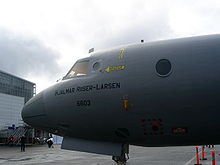Hjalmar Riiser-Larsen
Hjalmar Riiser-Larsen (born June 7, 1890 in Oslo , † June 3, 1965 in Copenhagen ) was a Norwegian aviation pioneer , polar explorer and businessman.
Riiser-Larsen entered the Norwegian Naval Academy at the age of nineteen and became a member of the newly formed Naval Air Force in 1915. After the First World War , he served as manager of the Naval Air Force factory until a senior officer was appointed. In 1921 he became a member of the Aviation Council, which was part of the Norwegian Defense Ministry as a secretariat. This move gave him the opportunity to study the young military and civil aviation infrastructures for which the council was responsible. He also flew frequently on the routes of the new airlines.
Polar research
Flight over the North Pole
Riiser-Larsen's years of polar exploration began in 1925 when his compatriot Roald Amundsen , the famous polar explorer, asked him if he would like to be his pilot when attempting to fly over the North Pole . Riiser-Larsen agreed and organized two Dornier Wal seaplanes. The expedition failed, however; one was forced to land near the pole and one of the planes was badly damaged. After twenty-six days on the ice, six hundred tons of snow had been shoveled to create a runway, the six members of the expedition squeezed into the remaining aircraft. Riiser-Larsen managed to get the overloaded plane to take off and lead the expedition to a happy ending.
The following year, Riiser-Larsen accompanied Amundsen on a new attempt. Together with the Italian Umberto Nobile , the American Lincoln Ellsworth and 12 other companions, this time they flew in the airship Norge . After leaving Svalbard on May 11, 1926, the overflight succeeded two days later and landed near Teller, Alaska . The men aboard the Norge are generally considered to be the first people to have demonstrably reached the North Pole with their overflight, as neither Frederick Cook , Robert Peary or Richard Byrd could fully prove their claims before .
In 1928 Riiser-Larsen took part in the search for his comrade Umberto Nobile , who had crashed on an Italian expedition to fly over the pole. Even when Amundsen's seaplane went missing, he took part in the search. Nobile and his team were found, but Amundsen was lost.
The expeditions with the Norvegia
The Norvegia expeditions were part of the Antarctic expeditions financed by the Norwegian ship owner and whaler Lars Christensen in the 1920s and 1930s . The alleged goals were scientific research and the discovery of new whaling grounds, but Christensen also asked the Norwegian Foreign Office for permission to claim discovered territories for Norway. At the end of the second expedition, two small islands in the Southern Ocean were Norwegian, Bouvet Island and Peter I Island .
In 1929, Christensen decided to use aircraft on the next expedition and appointed Riiser-Larsen to head the operation. Riiser-Larsen subsequently took part in the mapping of most of the Antarctic in this and three other expeditions. More territory was also taken over for Norway, namely Queen Maud Land .
Honors
The Riiser-Larsen Ice Shelf , Mount Riiser-Larsen , the Riiser-Larsen Peninsula , the Riiser-Larsen Sea and, indirectly, the Riiser-Larsen Basin in the Antarctic are named after him.
Business and war
In 1939 the Norwegian military was downsized and Riiser-Larsen was among the officers who were fired. However, the shipping company Fred. Olsen & Co. quickly offered a new job as head of the newly formed airline DNL . He invited several former naval pilots to work for him and quickly made the company very successful. In 1946 the DNL should be one of the four Scandinavian airlines that merged to form what is now the Scandinavian Airlines System (SAS).
When the German Reich occupied Norway in 1940 as part of the Weser Exercise Company , Riiser-Larsen rejoined the Norwegian Naval Air Force, which, like the entire army, was defeated by the Wehrmacht so soon that Riiser-Larsen was not used in combat. Instead, he accompanied the Norwegian cabinet and military leadership into exile in London before going to Toronto to become the first commander of the Norwegian air force training camp Little Norway .
At the beginning of 1941 Riiser-Larsen returned to London to first take over command of the Navy Air Force, then that of the United Air Force and finally, in 1944, that of the entire Norwegian Air Force. At the end of the war, however, his leadership style was criticized by so many of the pilots that he bitterly resigned in 1946.
Return to business
In 1947 Riiser-Larsen was again head of DNL, which, however, merged a few months later with three other Scandinavian airlines to form SAS . Riiser-Larsen then became a consultant and regional manager, responsible for transcontinental aviation routes. One of these routes, although only established after his retreat in 1955, was the “fulfillment of his vision”: the route to North America via the North Pole .
Riiser-Larsen died on June 3, 1965, four days before his seventy-fifth birthday.
| personal data | |
|---|---|
| SURNAME | Riiser-Larsen, Hjalmar |
| BRIEF DESCRIPTION | Norwegian aviation pioneer, polar explorer and businessman |
| DATE OF BIRTH | June 7, 1890 |
| PLACE OF BIRTH | Oslo |
| DATE OF DEATH | June 3, 1965 |
| Place of death | Copenhagen |


